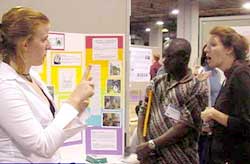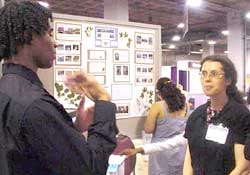Stars and STEM Stories
Students Wow American Geophysical Union
Earth and space scientists from the American Geophysical Union were so impressed with presentations by a group of GLOBE students at a recent meeting, the adult experts intend to invite such students back to future sessions. Nine GLOBE students from the Gallaudet Model Secondary School for the Deaf in Washington, DC recently attended and presented at the AGU meeting. The students' involvement was part of AGU's effort to increase the participation of underrepresented groups in the earth and space sciences by getting students interested before they even reach college. The students from Gallaudet attended a day-long program entitled "Expanding Horizons for Tomorrow's Scientists," organized by Jill Karsten, manager of education and career services programs at AGU. Prominent earth and space scientists addressed the group. In addition to a question and answer session with the scientists and a greeting by AGU President Marcia McNutt, GLOBE students presented their own research in the poster session "Looking to Tomorrow: Research Projects of High School-Aged Geoscientists."
"Inviting high school students to participate in the Spring AGU meeting was a bit of an experiment," Karsten said, "but everyone involved came away with the feeling that it was a resounding success!"

The seniors from Gallaudet presented two research projects that were part of teacher Mary Ellsworth's Earth System Science Class. In one project, students used the GLOBE Green-Up Phenology Protocol to study the timing of budburst of two native trees, a Silver Maple and a Crabapple. Tina, Kryzysztof, Les, Ebony, Nicole, and Trey each chose to observe a branch on one of the trees.
"Each day we described the stage of the buds on our branch, drew a sketch of our branch in our notebooks, and took the air temperature and precipitation measurements from our nearby Atmosphere Shelter," Les said. The buds on the Crabapple burst on February 28 and on the Silver Maple on April14 and 15, much later. "I was surprised that there was such a big difference in the timing of budburst for these two trees," Tina mentioned.
Since budburst can be used to examine regional and global vegetation patterns, the students will compare their data with two other schools, one in Indiana and one in California. The students enjoyed monitoring their branches for budburst timing and are looking forward to doing the same next year so that they may compare budburst dates of the same branches in different years.
A second group of Gallaudet students presented their work on the response of leaf reflectance to environmental or moisture variations. Caitlin studied the change in reflectance of infrared (IR) light by the leaves of a houseplant by controlling the amount of moisture the plant received. Using ALTA Reflectance Spectrometer to measure IR, she found a high correlation between the moisture content of the soil and the reflectance of IR1. Caitlin expressed satisfaction with this result. "We studied the structure of the leaf, and I expected more IR to be reflected when there was more water in the leaf."
Rochella and Ashley performed the experimental portion of this project by measuring the IR reflectance from leaves on trees and bushes. They had no way to control the soil moisture so they used their precipitation measurements to compare with the leaf IR reflectance data they collected.
"At first we didn't see the result we expected; it looked like there was no correlation between rainfall and IR reflectance," Rochella said. "Then, we shifted the data by one or two days and then we saw a strong correlation. It must take some time from when it rains to get the moisture into the leaves."

"Our work is significance for satellites studying vegetation because the same type and or amount of vegetation can appear differently because of moisture content in the leaves," Ashley added.
Student Ebony said that all the students were very proud to be at AGU. "We just felt positive and motivated to do the work," she said. Classmate Rochella agreed, saying, "I wish all students could have a chance like I had because I learned so much on that day and I realized that I love science, I love to see what is happening with the Earth."
AGU's Jill Karsten was also pleased with the students' presentations.
"In the afternoon poster session, the participating students were very impressive, both in their professionalism and their level of scientific interest," Karsten said. "Many AGU members who had the opportunity to visit the poster session and chat with the students told me afterwards that they were extremely pleased with the event."
26 June 2002





